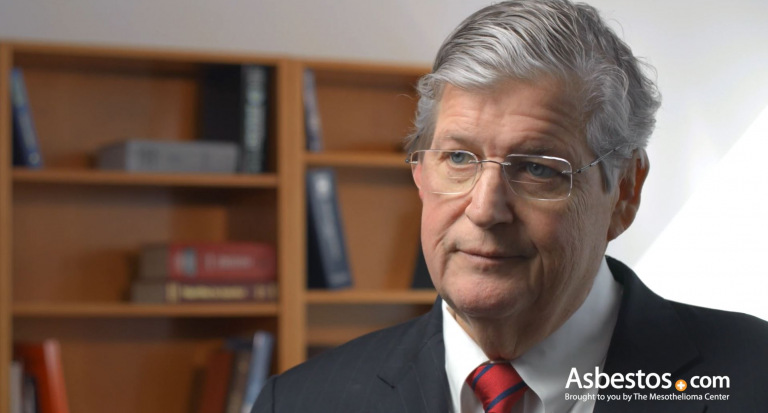
Dr. Jacques Fontaine is a thoracic surgeon at Moffitt Cancer Center in Tampa, Florida, where he heads up the Mesothelioma Research and Treatment Center. He specializes in minimally invasive robotic surgery and aggressive surgeries for mesothelioma.
Multimodal therapy for mesothelioma is a combination of types of cancer treatments. These options include immunotherapy, chemotherapy, surgery and radiation to improve survival and quality of life. Doctors tailor each plan to your diagnosis, health and disease stage.

Exclusive Content
Dr. David Sugarbaker: The Importance of Multimodal Therapy for Mesothelioma Treatment
"Most helpful, steered us in the right direction for treatmen..." see more
Elaine C. - Mesothelioma Patient
"Because of their guidance, I was able to navigate getting my..." see more
Deanna B. - Daughter of a Mesothelioma Patient
"Hearing the news about my mother's diagnosis was heartbreaki..." see more
Danielle W. - Daughter of a Mesothelioma Patient
"My son Carlos was diagnosed with this terrible and unknown d..." see more
Martha M. - Mother of a Mesothelioma Patient
"Extremely communicative and helped my dad get an appointment..." see more
Sunni H. - Loved One of a Mesothelioma Patient
"Danielle DiPietro was an invaluable resource for me. Her sug..." see more
Deborah C. - Spouse of a Mesothelioma Patient
"I was very grateful and appreciative of Dr. Smart from The M..." see more
Kimberlin C. - Spouse of a Mesothelioma Patient
"In January of 2016, my husband was diagnosed with peritoneal..." see more
Gloria R. - Spouse of a Mesothelioma Patient

Exclusive Content
Dr. David Sugarbaker: The Importance of Multimodal Therapy for Mesothelioma Treatment
Multimodal therapy for mesothelioma combines different treatments to attack the cancer from multiple angles. “Bimodal therapy” combines 2 therapies. “Trimodal therapy” combines 3 therapies. Each therapy does something different and works together to target different aspects of the disease.
The best multimodal treatment plans can extend patient survival for 2 to 5 years or more. Some long-term survivors have lived 10+ years from the time of their diagnosis.
Key Facts About Mesothelioma Multimodal Therapy
Your multimodal team will include different types of mesothelioma doctors and care experts who work together. This may include a surgeon, cancer doctor (oncologist), radiation doctor, nurses and a licensed dietitian. A multimodal approach for mesothelioma usually focuses on tumor-removing surgery with chemo and radiation therapy given before, after or during surgery.
A multimodal approach harnesses the power of multiple mesothelioma treatments. Each adds a key strength, creating a more complete and effective way to fight disease. Combining mesothelioma drugs, procedures, physical therapy and localized therapy can better control tumor growth, stop cancer from coming back, extend survival and offer greater quality of life.
Your doctor will recommend the exact combination best for you. Which therapies are chosen depends on which type of mesothelioma you have and your overall health.
Mesothelioma Multimodal Treatments
For pleural patients a multimodal treatment with immunotherapy, chemo, surgery and radiation is most common. For peritoneal patients, a bimodal approach using tumor-removing (cytoreductive) surgery and HIPEC has shown 5+ year survival in many people. In advanced cases, immunotherapy with chemo or TTF added may help control cancer cell growth and symptoms.
Multimodal therapy continues to be used more often. Research in 2024 and 2025 shows improved survival with multimodal therapy for mesothelioma. While not an immediate cure, these combination treatments offer hope of extended survival.

We’ll get you the best doctor for your diagnosis and schedule appointments with them quickly.
Find My DoctorCutting-edge approaches are improving outlooks for people with mesothelioma. Once new therapy combinations like immunotherapy with chemo or TTFields and chemo were significant breakthroughs and are now FDA-approved. Clinical trials are ongoing for emerging treatment combinations.
Emerging Mesothelioma Multimodal Therapies
New mesothelioma treatments, such as CAR T-cell therapy and targeted gene-blocking drugs, show promise, and doctors hope these will become part of multimodal treatments. But they’re still under investigation.
Accessing new therapies and new combinations often requires trial participation, highlighting the need for expanded treatment options and further research. A Patient Advocate can help find clinical trials recruiting patients and the top cancer centers offering them.
Timing plays a critical role in the effectiveness of multimodal treatments for mesothelioma. These treatments fall into 3 key categories based on when they’re given.
Categories of Mesothelioma Multimodal Treatment
This structured, phased approach maximizes the potential for long-term survival. It also includes tumor removal and prevention of cancer recurrence. Strategically timing treatments, taking a comprehensive approach, and tailoring treatment to your health represent the gold standard for improving mesothelioma prognosis.
Multimodal therapy for mesothelioma is a strong, aggressive approach that works best when the cancer is caught early. It’s also important that you are healthy enough to handle intense treatments. Your doctor will look at several factors to decide if combined treatments are right for you.
Factors That Influence Multimodal Therapy Eligibility
Your doctors will determine if you can safely tolerate the treatment and if your mesothelioma cells are likely to respond well. An early diagnosis and good overall health improve your chances of benefiting from multimodal therapy.
Multimodal therapy for mesothelioma has greatly improved life expectancy, especially for those diagnosed at earlier stages. A 2024 study in the Annals of Surgical Oncology found that patients who had P/D combined with chemo and immunotherapy lived a median of nearly 3 years. This is much longer than the 12 to 18 months survival seen with single treatments.
Personal stories reflect this progress. Jennifer Lucarelli, a pleural mesothelioma survivor, credits multimodal therapy for her recovery. Jennifer shares with us, “Surgery, chemo and radiation gave me a fighting chance. Five years later, I’m still here. Living, traveling and enjoying life.”
Outcomes vary depending on cancer stage, cell type and overall health. However, new treatments, including immunotherapy, TTFields and improved ways to combine therapies, offer people with mesothelioma even more hope. Regular follow-ups and participation in new clinical trials are continuously pushing survival rates higher.

Dr. Jeffrey Velotta, thoracic surgeon at Kaiser Permanente
Benefits:
Risks:
Your doctors assess your cancer stage and overall health to create a customized plan. If eligible, surgical procedures like P/D (lung-saving) or EPP (lung-removing) may be used to remove tumors.
Chemo drugs shrink remaining cancer cells before or after surgery. High-energy radiation beams target residual cancer cells to prevent regrowth. Regular scans and follow-ups track recovery progress and manage side effects.
Multimodal treatment for mesothelioma typically takes 3 to 6 months for the initial treatment (surgery, chemotherapy and radiation). Some people continue maintenance of their disease through immunotherapy or clinical trials for months or years. Lifelong monitoring is needed to detect recurrence early.
Stay up-to-date on treatment, research, clinical trials, doctors and survivors
The information on this website is proprietary and protected. It is not a substitute for professional medical advice, diagnosis or treatment. Any unauthorized or illegal use, copying or dissemination will be prosecuted. Please read our privacy policy and terms of service for more information about our website.
This website and its content may be deemed attorney advertising. Prior results do not predict a similar outcome.
The Mesothelioma Center’s claim as the most trusted resource is based on our more than 150 5-star Google and BBB reviews. Our organization also helps more than half of all mesothelioma patients annually diagnosed.
Your web browser is no longer supported by Microsoft. Update your browser for more security, speed and compatibility.
If you are looking for mesothelioma support, please contact our Patient Advocates at (855) 404-4592
Asbestos.com. (2025, December 11). Mesothelioma Multimodal Therapy. Retrieved December 18, 2025, from https://www.asbestos.com/treatment/multimodal-therapy/
"Mesothelioma Multimodal Therapy." Asbestos.com, 11 Dec 2025, https://www.asbestos.com/treatment/multimodal-therapy/.
Asbestos.com. "Mesothelioma Multimodal Therapy." Last modified December 11, 2025. https://www.asbestos.com/treatment/multimodal-therapy/.
The Mesothelioma Center at Asbestos.com has provided patients and their loved ones the most updated and reliable information on mesothelioma and asbestos exposure since 2006.
Our team of Patient Advocates includes a medical doctor, a registered nurse, health services administrators, veterans, VA-accredited Claims Agents, an oncology patient navigator and hospice care expert. Their combined expertise means we help any mesothelioma patient or loved one through every step of their cancer journey.
More than 30 contributors, including mesothelioma doctors, survivors, health care professionals and other experts, have peer-reviewed our website and written unique research-driven articles to ensure you get the highest-quality medical and health information.
My family has only the highest compliment for the assistance and support that we received from The Mesothelioma Center. This is a staff of compassionate and knowledgeable individuals who respect what your family is experiencing and who go the extra mile to make an unfortunate diagnosis less stressful. Information and assistance were provided by The Mesothelioma Center at no cost to our family.
Lashawn , Mesothelioma patient’s daughter


We Thoroughly vet individuals who are experts in their field to contribute to articles on Asbestos.com. We believe in the integrity and quality of our educational materials, and only publish information that is relevant, factual, and backed by experts.


Dr. Jacques Fontaine is a thoracic surgeon at Moffitt Cancer Center in Tampa, Florida, where he heads up the Mesothelioma Research and Treatment Center. He specializes in minimally invasive robotic surgery and aggressive surgeries for mesothelioma.
Our fact-checking process begins with a thorough review of all sources to ensure they are high quality. Then we cross-check the facts with original medical or scientific reports published by those sources, or we validate the facts with reputable news organizations, medical and scientific experts and other health experts. Each page includes all sources for full transparency.
Please read our editorial guidelines to learn more about our content creation and review process.
